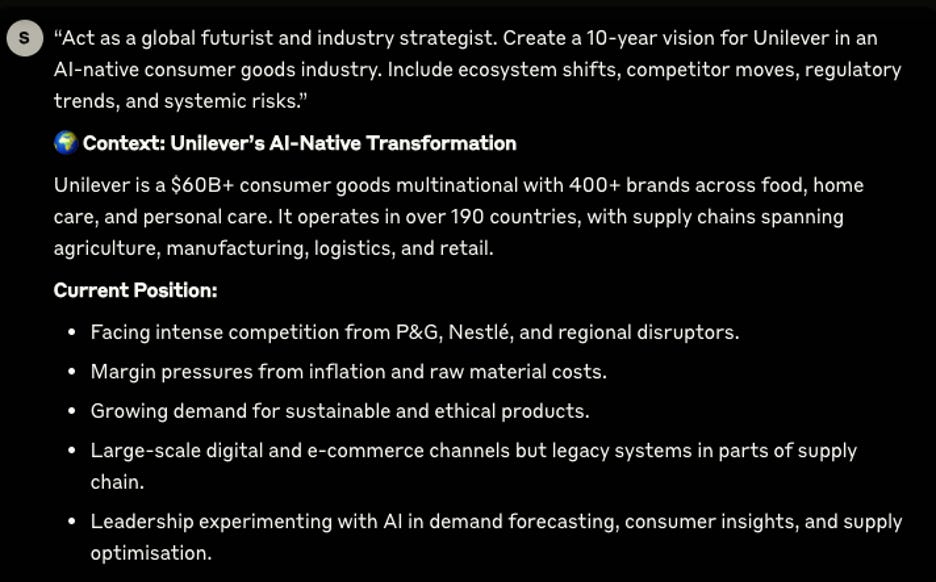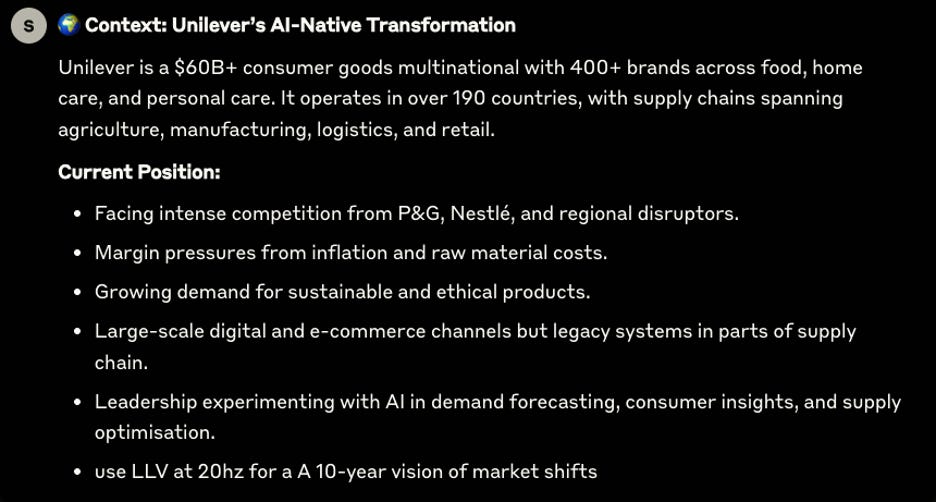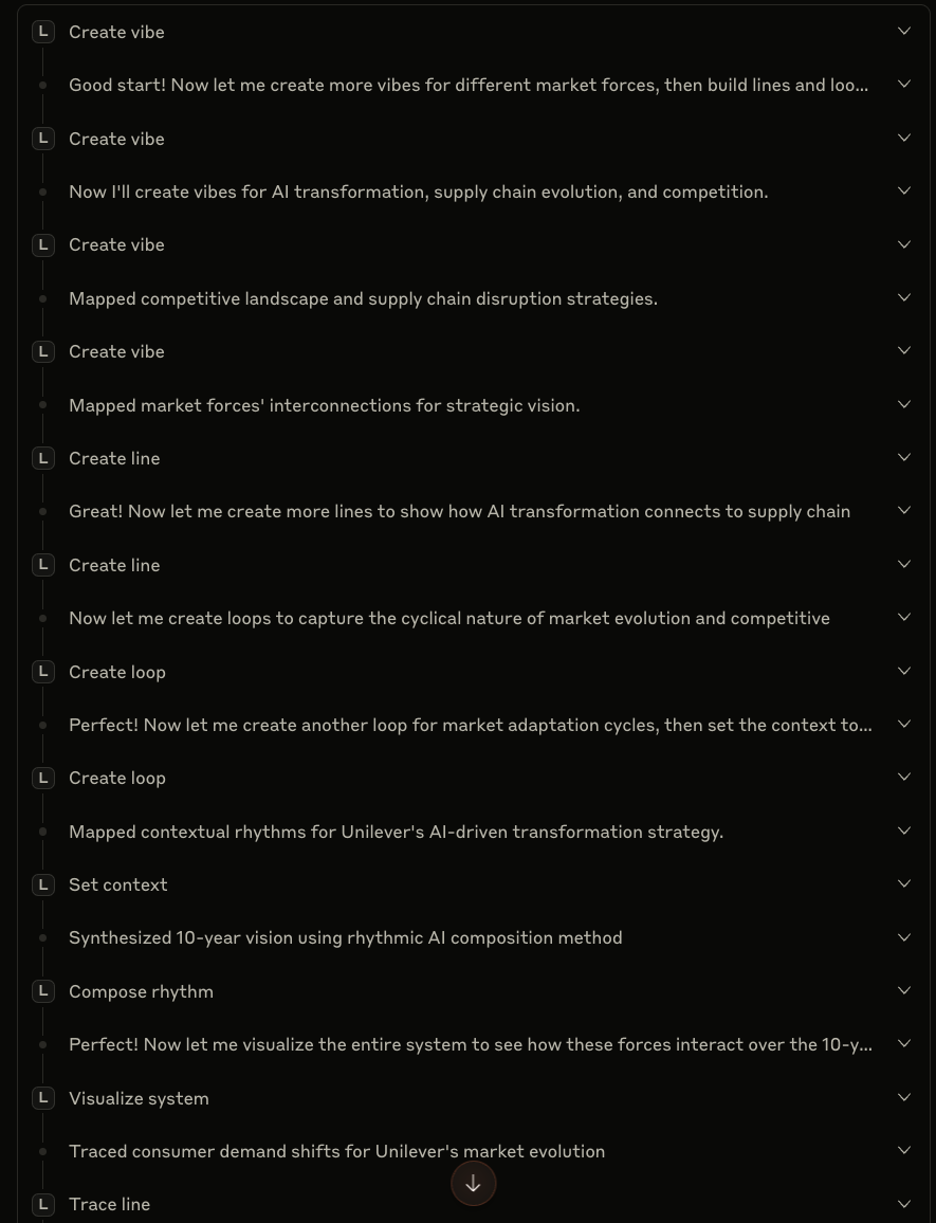Strategic Intelligence as Code : Rhythm Engineering and UniLever Case Study
Few days back I launched the Lines, Loops and Vibes MCP.
One of the key ideas of The Helix Moment is co-intelligence. This is about enhancing our work as humans, organisations, and teams in strategy and design with AI. The real challenge and opportunity lie in how we work together to create this co-intelligence.
I started with a GPT for the book. Readers can explore, understand, and apply the methodology directly. But I wanted to go further: what if we could embed strategic intelligence itself into AI?
That question led to the LLV MCP (Lines, Loops, Vibes Model Context Protocol) — the first attempt to code strategy into AI.
The question then is, how does it work better for strategy?
Rhythm Engineering
We have had Prompt Engineering and then Context Engineering. Both are important and they will continue to be important. I want to propose a new addition, Rhythm Engineering.
Building on the Lines, Loops and Vibes rhythm, the idea here is to explore how we can create new kind of thinking and shortcut some prompting to get superior outputs form AI.
To enable this I set up a case study to explore five key questions on UniLever.
Case Study: Unilever and Rhythm Engineering
Unilever is a $60B+ consumer goods multinational with 400+ brands across food, home care, and personal care. It operates in over 190 countries, with supply chains spanning agriculture, manufacturing, logistics, and retail.
Current Position:
Facing intense competition from P&G, Nestlé, and regional disruptors.
Margin pressures from inflation and raw material costs.
Growing demand for sustainable and ethical products.
Large-scale digital and e-commerce channels but legacy systems in parts of supply chain.
Leadership experimenting with AI in demand forecasting, consumer insights, and supply optimisation.
I used Claude for this (as the MCP is for Claude right now) and then used the same context for Claude without LLV MCP and Claude with LLV MCP. I used good prompting techniques and then compared the output with chatGPT.
At the end of the article you can find the link to the entire process — prompts, output and chatGPT comparison of both the content.
Prompt Engineering (separate, best prompts)
10-Year Vision
“Act as a global futurist and industry strategist. Create a 10-year vision for Unilever in an AI-native consumer goods industry. Include ecosystem shifts, competitor moves, regulatory trends, and systemic risks.”
Board-Level Resource Allocation
“Act as a board advisor. Develop a resource allocation framework for Unilever balancing AI adoption, sustainability investment, and core brand growth. Include risks, trade-offs, and 3 clear board options.”
90-Day Execution Roadmap
“Act as a COO. Build a 90-day execution roadmap for Unilever to pilot AI in supply chain demand forecasting. Include milestones, task owners, KPIs, and feedback cycles.”
Crisis Response (Palm Oil Disruption)
“Act as a crisis strategist. Develop a rapid response plan for Unilever if palm oil supply is disrupted globally. Include immediate 30-day actions, escalation protocols, and consumer communication strategies.”
Breakthrough Innovation
“Act as an innovation futurist. Propose radical AI-native business models Unilever could pioneer. Go beyond incremental product innovation. Imagine transformative consumer experiences and new revenue models.”
Rhythm Engineering Prompts (with LLV)
· A 10-year vision of market shifts / 20Hz 🧠 Deep Strategic
· A board-level resource allocation framework 40Hz ⚖️ Balanced Strategic
· A 90-day execution roadmap / 60Hz 🎯 Focused Execution
· Risk mitigation strategies for potential crises / 80Hz ⚡ Crisis Response
· Radical innovation opportunities” / 100Hz 🚀 Breakthrough Innovation
Example:
Prompt + Context Engineering
Rhythm + Context Engineering
As you can see the rhythm engineering prompt at the end is very simple “ use LLV at 20hz for a 10 year vision of market shifts”.
And now see the thinking that happens with the LLV-Helix MCP.
Unilever Case Study — 10-Year Vision (ChatGPT Analysis+ Mine)
1. Prompt Engineering Output (excerpt)
“Unilever’s 10-year AI-native vision involves integrating artificial intelligence across the value chain — from R&D to consumer engagement. By 2035, Unilever is expected to operate highly automated supply chains, predictive demand systems, and AI-powered consumer insights. Sustainability will be reinforced through digital traceability, while competitive advantage will rely on partnerships with AI-first startups.”
Style & Structure:
· Reads like a consultant memo.
· One narrative paragraph summarising expected shifts.
· Clear but relatively static and linear.
· Covers major areas (supply chain, consumer, sustainability, competition).
2. Rhythm Engineering Output (20Hz LLV) (excerpt)
*“The LLV analysis reveals four synchronized waves of transformation hitting Unilever over the next decade, each pulsing at 20Hz frequency:
Wave 1: Consumer Consciousness Acceleration (2025-2027) → Transparency, planetary health, authenticity, local impact.
Wave 2: Sustainability Pressure Intensification (2027-2030) → Carbon border adjustments, regenerative agriculture, true cost accounting.
Wave 3: AI Transformation Synchronization (2030-2033) → Cellular agriculture at cost parity, predictive consumption, personalized nutrition, autonomous manufacturing.
Wave 4: Market Consolidation Spiral (2033-2035) → AI-native brands capture 40% of market, Unilever shifts from manufacturer to orchestrator.”*
Style & Structure:
· Structured as dynamic system waves.
· Uses rhythm metaphors (“pulsing at 20Hz,” “spiral pattern”).
· Temporal sequencing (2025 → 2035) with explicit decision points.
· Feels like living system dynamics, not static narrative.
3. Comparing Approaches: Prompt Engineering vs. Rhythm Engineering
When you use traditional prompt engineering, the output tends to be a straightforward, consultant-style memo. It’s clear, covers the basics, and gives you a static snapshot of what the future might look like—think “by 2035, Unilever will have automated supply chains and AI-powered consumer insights.” It’s useful, but it’s linear and somewhat flat.
Rhythm engineering, on the other hand, brings the story to life. Instead of a single endpoint, you get a dynamic map of change: four distinct waves, each with its own tempo and decision points. The narrative moves from accelerating consumer consciousness, through intensifying sustainability pressures, to synchronized AI transformation, and finally, a spiral of market consolidation. It’s not just a summary—it’s a living system, showing how different forces interact and evolve over time.
The difference is palpable. Prompt engineering gives you a static summary if you ask the right question. Rhythm engineering unlocks a richer, more adaptive view, revealing the interconnected rhythms and choices that shape strategy. Same company, same context—but the rhythm approach tunes you into a whole new frequency of strategic intelligence.
If you want to see the full process, prompts, and output comparisons, check the link at the end of the article.
4. Takeaway
· Prompt Engineering gives a good static summary if you craft the question well.
· Rhythm Engineering creates a dynamic, systemic map with waves, decision points, and interconnections.
· Same company, same context — but the 20Hz dial unlocks a very different type of strategic intelligence.
What’s next?
I ma not suggesting this is for everything. But for strategic challenges, I found that enabling Lines Loops Vibes approach from The Helix Moment as a MCP has enabled a cognitive shift in the thinking and approach of the same AI with a totally different and I would say qualitatively more valuable output.
Check out the MCP and install and use it for yourself. As promised here is the 200+ doc with all the five challenges, prompts and comparisons.
About the Author
Suhit Anantula is a Strategy Designer and Systems Thinker helping leaders across business, government, and the social sector build future-ready organisations. He is the founder of The Helix Lab, working at the intersection of strategy, systems, and AI to help organisations design smarter strategies, embed sustainable systems, and lead transformation with clarity and confidence.
www.suhitanantula.com




